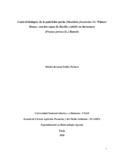Mostrar el registro sencillo del ítem
Control biológico de la pudrición parda (Monilinia fructicola) (G. winter) Honey, con dos cepas de Bacillus subtilis en duraznero (Prunus persica [l.] batsch).
| dc.contributor.advisor | Fónseca, Jorge Armando | |
| dc.coverage.spatial | cead_-_Tunja | spa |
| dc.creator | Patiño Pacheco, Mónica Jovanna | |
| dc.date.accessioned | 2020-07-03T00:59:58Z | |
| dc.date.available | 2020-07-03T00:59:58Z | |
| dc.date.created | 2020-06-30 | |
| dc.identifier.uri | https://repository.unad.edu.co/handle/10596/35153 | |
| dc.description.abstract | La pudrición parda causada por Monilinia fructicola, es la enfermedad fúngica más importante en el cultivo de duraznero a nivel mundial, reduce la calidad y rentabilidad de las cosechas. Bacillus subtilis es un biopesticida que utiliza diferentes mecanismos en el control de fitopatógenos, sin ejercer un impacto negativo en el entorno. Por ende, el objetivo de este trabajo fue, evaluar el efecto antifúngico de dos cepas de Bacillus subtilis (CB10 y CB11), y un fungicida (Dicloram) contra la pudrición parda causada por (Monilinia fructicola) en duraznero. En pruebas in vitro se evalúo la tasa y halo de inhibición del patógeno. En frutos se evalúo la tasa de inhibición y el porcentaje de severidad de la enfermedad después de la inoculación con el patógeno. Según, los resultados en pruebas in vitro se demostraron que la cepa CB10 de B. subtilis registró una tasa de inhibición del 88, 5% y un halo de inhibición de 14 mm controlando el crecimiento y esporulación del patógeno. En frutos inoculados con la misma cepa, se registró una tasa de inhibición del 95% y una severidad menor al 10%. Los tratamientos con el fungicida y la cepa CB11 de B. subtilis, la tasa de inhición fue del 70% y la severidad fue del 30 – 35% en frutos inoculados. Como conclusión de este trabajo se puede afirmar que la cepa CB10 de B. subtilis puede utilizarse en el control biológico de M. fructicola, garantizando un manejo más eficiente y ecológico de este patógeno. | spa |
| dc.format | ||
| dc.title | Control biológico de la pudrición parda (Monilinia fructicola) (G. winter) Honey, con dos cepas de Bacillus subtilis en duraznero (Prunus persica [l.] batsch). | |
| dc.type | Proyecto de investigación | |
| dc.subject.keywords | Enfermedad de las plantas. Hongo, Crecimiento, Fungicida, Fitopatología. | spa |
| dc.description.abstractenglish | Brown rot caused by Monilinia fructicola, is the most important fungal disease in peach cultivation worldwide, reduces the quality and profitability of crops. Bacillus subtilis is a biopesticide that uses different mechanisms to control plant pathogens, without having a negative impact on the environment. Therefore, the objective of this work was to evaluate the antifungal effect of two strains of Bacillus subtilis (CB10 and CB11), and a fungicide (Dicloram) against brown rot caused by (Monilinia fructicola) in peach tree. In vitro tests evaluated the rate and halo of inhibition of the pathogen. In fruits, the inhibition rate and the percentage of severity of the disease were evaluated after inoculation with the pathogen. According to, the results in in vitro tests showed that the B. subtilis strain CB10 registered an inhibition rate of 88, 5% and a halo of inhibition of 14 mm controlling the growth and sporulation of the pathogen. In fruits inoculated with the same strain, an inhibition rate of 95% and a severity of less than 10% were recorded. Treatments with the fungicide and the CB11 strain of B. subtilis, the inhibition rate was 70% and the severity was 30 - 35% in inoculated fruits. As a conclusion of this work, it can be stated that the CB10 strain of B. subtilis can be used in the biological control of M. fructicola, guaranteeing a more efficient and ecological management of this pathogen. | spa |















